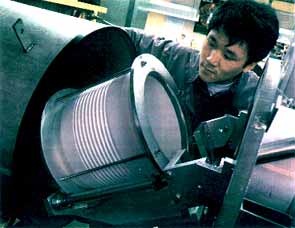|
To inject energetic electrons into the Thomas Jefferson National
Accelerator Facility's free electron laser, scientists at the facility in
Newport News, Virginia, built a Photo-Emission Electron Gun designed to
operate in vacuum at half a million volts. The gun's "barrel" is
a pair of cylindrical ceramic insulators, known as accelerator columns,
made of pure alumina and capable of withstanding the high voltage.
 |

BERKELEY LAB'S FENGHUA LIU, PICTURED WITH THE "ROTISSIERE,"
DESIGNED TO BLEED AWAY A CHARGE AND PREVENT CATASTROPHIC FLASHOVER
|
No matter how good an insulator may be in bulk, however, its surface is
vulnerable to failure. In a strong electric field, free electrons can be
accelerated onto its inner surface. A single electron impact may scatter
one or two or more electrons, which impact the surface in turn.
As surface atoms lose more and more electrons, positive charge quickly
develops and still more electrons are launched. In an instant, an
avalanche of electrons is rolling over the surface in a catastrophic
flashover.
"Flashovers not only bring operations to a halt, they can do
expensive damage," says physicist Larry Phillips of Jefferson Lab.
"When we built the electron gun we knew that a big problem would be
to operate it at high electric field strength without breakdown."
One way to prevent flashover is to add some conductivity to the surface
of the insulator, so charge can bleed away before it builds up. "In
our first columns we fired on a thick coat of rare metal oxides,"
says Phillips, "but the coating behaved erratically and the columns
still broke down a lot."
Then, at an accelerator conference held in Washington DC in 1993,
Phillips heard a talk by Berkeley Lab's Simone Anders on controlling the
surface resistivity of ceramics using metal ion implantation. "It
sounded like it might be the answer to my problem," Phillips says,
"which shows you the importance of going to conferences!"
Anders, then a scientist with the Plasma Applications Group in Berkeley
Lab's Accelerator and Fusion Research Division (AFRD) headed by Ian Brown,
described a vacuum-arc ion source of the group's invention which, says
Brown, "had shown nice characteristics for certain kinds of implants.
It is very good at putting metal into alumina, for example."
In the vacuum-arc implanter, a broad beam of ions formed from a cathode
of the metal or alloy to be implanted propagates through a vacuum chamber
toward the target. The device was originally built to produce beams of
uranium ions for the Bevalac. After the Bevalac was decommissioned
"our research evolved toward ion implantation. This kind of ion
source and ion implantation works so well it has been copied at many
laboratories around the world."
Brown, Phillips, and their colleagues at Berkeley Lab and Jefferson Lab
joined forces to investigate the possibilities of using metal ion
implantation to lick the flashover problem. They began by implanting small
ceramic coupons with titanium, gold, and platinum.
"Ideally you want a good insulator with a surface that's just
slightly resistive, so charge can drain off," Brown explains,
"and you want the resistivity even over the length of the
ceramic."
Tests established that indeed surface resistivity could be controlled
by implanting metal ions; with energies at 135 keV (135 thousand electron
volts), ions were implanted into the surface of the material to about 300
angstroms deep (30 billionths of a meter). The collaborators decided to
use platinum, which does not oxidize and makes a good cathode material.
The remaining challenge was to scale up the process from samples the
size of postage stamps to cylinders as big as cooking pots. The Jefferson
Lab team built a special cradle to fit on the target end of the implanter,
tilted to hold the cylinder at a 55-degree angle to the ion beam and
fitted to slowly rotate it as the broad beam played over the entire inner
surface. The device was immediately nicknamed the "rotisserie."
Implantation is periodically halted to check the surface, until
resistance is lowered to the desired value. "We are used to dealing
with targets a hundred times smaller and implantation times of a few
minutes to a few hours," Brown says, "It takes several days to
process a single accelerator column, running the ion source at maximum
beam."
Brown credits physicist Efim Oks of the High-Current Electronics
Institute in Tomsk, Russia, currently working with AFRD's Plasma
Applications Group in a collaboration funded by the Department of Energy,
for "getting the ion source operating at twice its former
efficiency."
Three accelerator columns are presently being implanted with platinum
ions, in addition to three implanted in an earlier joint effort. Two
columns have already been assembled in the electron gun at Jefferson Lab.
"We've had no problems whatsoever," says Larry Phillips;
indeed the gun quickly began operating at far higher efficiency than
before. So encouraging are the results that a second electron gun is
planned.
Jefferson Lab's free-electron laser, which has already achieved
energies of 1.7 kilowatts, is being upgraded to far higher 10-kilowatt
energies. Larry Phillips says a long line of potential users from
universities and industries are already in line for the versatile machine,
"a machine I'm very enthusiastic about."
Essential to the upgraded free-electron laser is a dependable
high-voltage electron gun. By tailoring the surface resistivity of its
accelerator columns through metal ion implantation, the collaborators have
met a major challenge to operating the gun at high field strengths without
breakdown.
Additional information:
|


